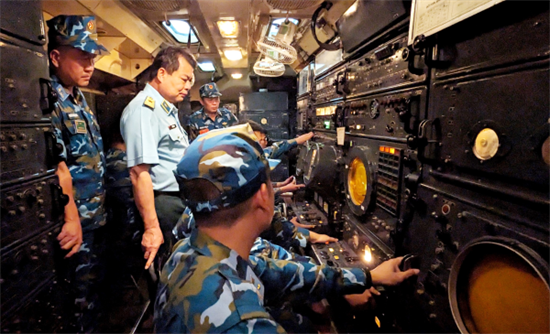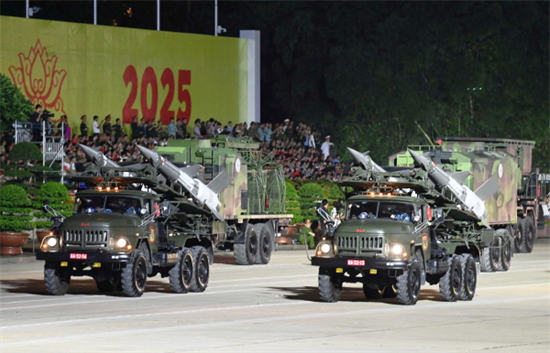Building the Air Defence - Air Force Service straight to modernity is a strategic guideline, reflecting the close attention of the Party, State, Central Military Commission (CMC), and Ministry of National Defence (MND). Fully aware of its great honour, the Air Defence - Air Force Service has been focusing its leadership and direction on realising this crucial goal through resolute and synchronised measures.
Thoroughly grasping their great responsibilities for the special attention and investment of the Party, State, CMC, and MND in the modernisation process, over the years, the Air Defence - Air Force Service’s Party Committee and Command have concentrated their leadership and direction on taking all-round, synchronised measures to successfully fulfil the established targets, with a view to constantly enhancing the Service’s synergy and combat strength, deserving to be the core force on air combat front, closely managing and firmly protecting the Fatherland’s airspace in any situations.
 |
| The Service Command inspects combat readiness work |
With political resolve and drastic involvement of all-level party committees and commands, the building of a modern Service has obtained many encouraging results. Force adjustments within offices and units across the Service have been conducted in an adept, compact, strong manner. Units have received, managed, mastered, and effectively used modern weapons, military hardware, and equipment. There have been reforms in training and exercises relevant to each force’s tasks. The Service’s combat power and combat readiness capacity have been step by step enhanced. Due regard has been paid to airspace management and flight operations control, with proactive detection and prompt handling of situations, thereby avoiding passivity, surprises, errors, and omissions.
At present and in the time ahead, more demanding requirements are imposed on national defence consolidation, Fatherland protection, and Army building; the task of managing and protecting the airspace becomes increasingly arduous and complex. The rapid development of military science and technology has led to the emergence of many modern weapons and unpredictable changes in air warfare, thus posing more serious challenges to the Service.
Against that backdrop, it is vital to step up the building of an adept, compact, strong, modern Air Defence - Air Force Service capable of playing a core role in managing and protecting the Fatherland’s territorial sovereignty, airspace, seas, and islands. To that end, the Service will continue remaining unity, promoting its synergy, and comprehensively implementing various measures, with a focus on the following.
First of all, continuing to consolidate the Service’s organisational structure in an adept, compact, strong fashion, building a politically strong Service. The Service’s Party Committee and Command will direct offices and units to consolidate their organisational structure under the MND’s guidance, ensuring a balance between offices and units, giving priority to providing sufficient personnel, weapons, and equipment, especially new and modern arms and technical means for combat-ready units, key mission forces, newly-established or re-organised units, and forces moving straight to modernity. The Service will conduct force adjustments within its offices and units in accordance with modern warfare, ensuring “a single command, a crucial task, clear responsibilities, and streamlined structure”. It will closely collaborate with competent agencies to give advice to the CMC and MND on issuing new organisational structure, functions, and tasks of the air defence - air force and establishing mobile units capable of deploying troops and means on different types of terrain, carrying out multi-domain operations, and meeting the requirements of hi-tech warfare, and asymmetric, non-contact warfare.
Furthermore, the Service will direct its affiliates to grasp resolutions and directives by the Party, CMC, and MND on military and defence tasks, on partners of cooperation and objectives of struggle, on hostile forces’ plots and artifices, and on the Service’s tasks in order to raise troops’ awareness and sense of responsibility in task execution. It will effectively execute the Project on renewing political education within units in the new period. In the process, it will closely combine political education with discipline management, history education, and tasks-related education. It will continue well implementing the Determined to Win Emulation Movement, emulation drives, and campaigns, particularly the Campaign on promoting tradition, devoting talent, deserving to be “Uncle Ho’s Soldiers” in the new era. It will seriously realise resolutions and directives on Party building work, on example-setting responsibility of cadres and party members, and on things that party members must not do. It will direct all-level party committees and party organisations to comply with regulations on Party meeting, renew their leadership style and management methods, enhance the management, education, and training of cadres and party members, build a pool of party members, cadres, and party committee members, and align the building of typically strong, pure party organisations with the building of “exemplarily, typically” comprehensively strong offices and units capable of all assigned tasks.
 |
| The Service’s weapons during the ceremony to celebrate the 80th anniversary of the National Day of the Socialist Republic of Vietnam (2 September 1945 - 2 September 2025) |
Second, improving the quality of training, combat readiness, and education for target individuals. The Service will require all offices and units to continue grasping resolutions and directives by the CMC, the MND, and the Service Party Committee on training and education. Based on those documents, training work will be comprehensively renewed to be relevant to combat realities, with combat tasks as the highest goal of training work. Offices and units across the Service will develop training plans for their troops in accordance with the characteristics of each group of weapons and their assigned tasks, while gradually standardising textbooks, lesson plans, and reference materials. Traditional training methods and forms will be closely combined with simulation and virtual reality training; combat training will be aligned with physical training; night-time, field training in harsh weather, electronic warfare, and cyber warfare conditions will be intensified. As for air force units, emphasis will be placed on training troops in long-distance maritime flight, night-time flight, complex-manoeuvre flight, formation flight, and advanced flight with experts on new aircraft as well as improving troops’ command capacity, piloting techniques, navigation skills, and capabilities in combat application. As for air defence units, importance will be attached to holding training courses to better combat coordination between forces, particularly between combat teams at all-level headquarters and enable troops to grasp and flexibly apply skills and rules of shooting targets in the air and under complex weather, hi-tech warfare, and intensive electronic warfare conditions, thus creating a closed, inter-connected, uniform defensive system. Consideration will be given to strictly maintaining combat readiness duty from the Service down to its grass-root units to firmly protect designated targets, promptly, effectively handle situations, and avoid falling into passivity.
Adhering to the motto “schools’ training quality is the combat readiness capacity of units”, schools across the Service will renew their training content, programs, procedures, and methods to be relevant to realities of training and combat readiness, actively apply science, technology, and digital transformation in education and training activities, make themselves regular, exemplary, standardised, and modernised, and expand groups of trainees. Significance will be attached to training key pilots and technicians capable of mastering the existing weapons and military hardware, particularly modern ones, and improving troops’ knowledge and skills in foreign languages, information technology, digital data exploitation, and automated system operation. Due attention will be paid to researching and proposing measures to attract and utilise high-quality human resources for the Service.
Third, enhancing science research, mastering hi-tech weapons, applying digital technology and artificial intelligence (AI) to combat management, command, and operation. The Service will direct its offices and units to grasp and effectively implement resolutions and directives by higher echelons on breakthroughs in science - technology development, innovation, and digital transformation, with emphasis placed on providing technical support for modern weapons and military hardware and improving the capability in combat management, command, and operation. Great value will be attached to developing automated command and control system integrated with digital technology and AI from the Service Headquarters to units’ headquarters and the ground-based air defence force and employing AI to carry out big data analysis and improve the capability in detecting, classifying, and forecasting the enemy’s movements and operational intent. The Service will continue researching and developing battlefield simulation and virtual training systems, including virtual reality, augmented reality, and 3D simulation technologies, with the aim of training troops to flexibly deal with complex combat situations in modern warfare. At the same time, it will focus on building and protecting database and military network, establishing military data centres with a high level of security, advanced encryption technology, and multi-layered cyber-attack prevention mechanisms in order to ensure the absolute safety of command and control systems and operational database.
The Service will concentrate on researching, designing, and translating training materials, bringing into play technical and tactical features of the existing weapons and military hardware, and mastering new, upgraded weapons and technical means. Besides, it will improve and perfect technologies for weapon and technical equipment repair, apply new technologies to the production of spare parts and materials as well as for designing and manufacturing new weapons, and gradually achieve self-reliance in manufacturing hi-tech weapons, equipment, materials, spare parts, thereby reducing dependence on imports. It will collaborate with competent agencies to give advice to the CMC and MND on investing in weapon acquisition, manufacture, and upgradation and accelerating the building of a modern Service; priority will be given to developing long-range early warning radar systems, multi-tier, multi-range air defence missile systems, new-generation multi-role fighter aircraft, reconnaissance and strike UAVs, modernising automated command and control systems, and addressing the relationship between human and weapons.
Fourth, focusing on raising the quality of regularity building and discipline management. The Service will keep grasping and seriously implementing resolutions, directives, and regulations on regularity building and discipline management. It will continue making a breakthrough in raising the quality of regularity building and discipline management, intensifying measures for troop management and training, creating a solid change in the observance of laws and discipline, aligning regularity building and discipline management with the building of a healthy military cultural environment, and multiplying role models in regularity building. It will build a scientific, modern, well-organised, and highly professional working environment, promote the role of party committees, commanders, and political agencies in providing education and orientation in terms of regularity building and discipline management for cadres and soldiers, minimise normal disciplinary violations, and prevent serious violations of discipline. It will conduct preliminary and final reviews to draw lessons on discipline management and consider the outcome of regularity building and discipline management as an important criterion for annual collective and individual assessment and commendation. Units across the Service will frequently organise cultural and sport activities to create joyful, healthy atmosphere, improve their troops’ mental life, and contribute to increasing their synergy and combat power in the new period.
Under the leadership and direction of the CMC and MND, with close coordination between forces and great resolve of cadres and soldiers, the Air Defence - Air Force Service will strive to successfully fulfil the goal of building a modern Service capable of managing and firmly protecting the Fatherland’s airspace in any situations, deserving the trust of the Party, State, Military, and people.
Maj. Gen. VU HONG SON
Commander of the Service